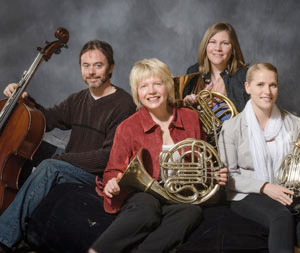by Daniel Hathaway

Music director Christopher Wilkins began the evening with a brief prolegomena, then introduced his assistant, Levi Hammer, who led a stirring performance of Zoltán Kodály’s Dances of Galanta from memory. Based on gypsy melodies collected in the Hungarian village of Galanta, the piece gave a few virtuosi in the orchestra their own cameo appearances: clarinetist Kristina Belisle Jones was splendid in two spiraling cadenzas and flute, piccolo and oboe contributed handsome lyrical passages. The ASO musicians gave Hammer a fraternal solo bow when he was called back to stage.
Though each of the four works on Saturday evening’s program called for at least four horns, Robert Schumann’s dramatic and demanding Concertstück brought four of those gleaming brass instruments front and center (while another pair stayed back in the orchestra). Here, the virtuosos of the moment were Meghan Guegold, Cynthia Wulff, Ken Wadenpfuhl and Stacie Mickens, who were just as impressive as a solo quartet as they are concert after concert as a section.
At the beginning of the 19th century, when horns hadn’t evolved much since they left the hunt and joined the orchestra, if you wanted to play in a different key, you had to swap out one “crook” or piece of plumbing for another. In his rarely-performed Concert Piece, Schumann set out to show what the newly-invented valve horn could do, and it’s provided a daunting challenge for hornists ever since its debut in 1849.
From the bracing opening fanfare, through the melodic Romanze to the cheerful, Mendelssohnian scherzo that brings the piece to a conclusion, the quartet played with fluency, spirit and stamina. And admirable accuracy. Considering the scary reality that if a hornist has the correct valve down, the right embouchure on the mouthpiece and the hand in the optimal position in the bell, things can still go wrong, it was wonderful to hear four players blaze their way through a piece of this complexity with scarcely a false note. The audience heralded the quartet’s efforts with a standing ovation.
Principal cellist Miles Richardson offered quite a different kind of piece after intermission. Gabriel Fauré’s Elegy gave him the opportunity to spin out long, poignant melodic lines and repeat them at whispery dynamic levels while still carrying through the orchestra. Affecting wind solos matched Richardson’s mood in this eight-minute gem, which provided a welcome moment of mid-concert repose. The cellist’s performance brought the audience to its feet for a second time.
Witold Lutoslawki’s three-movement Concerto for Orchestra — like Bartók’s — is a tour de force for the ensemble and its constituent parts, and — like Bartók’s — is based on folk themes. Wilkinson described its complexity and formal rigor beforehand in a pithy and descriptive talk, happily without making the musicians play examples.
Then Wilkinson and the Akron Symphony dived into Lutoslawki’s colorful rhapsody with gleeful élan, assisted by five busy percussionists and timpani. Thirty riveting and eventful minutes later, after every section had had its say and swirling winds had whipped up a maelstrom in the Toccata, the piece ended with a gloriously calm chorale and a stunning climax that brought the audience out of its seats for a third time. A special nod went to English horn soloist Cynthia Warren — one more Akron regular who reconfirmed her virtuoso creds tonight.
Published on ClevelandClassical.com March 4, 2014
Click here for a printable version of this article.



